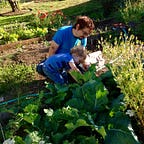Seek Out the Plants
Resolve to Cure Your Plant Blindness in 2018
Even though we depend upon them more than any other living thing on the planet (with the exception, perhaps, of soil microorganisms), most humans don’t see plants. Our inability to recognize our photosynthesizing neighbors is an actual, measurable phenomenon often referred to in “certain circles” as “Plant Blindness.”
Whether we’re looking at pictures or walking down the street, chances are we’re almost completely ignoring the plant life that surrounds us. According to authors James H. Wandersee and Elisabeth E. Schussler, who discuss the condition in Plant Science, the Bulletin of The Botanical Society of America, there are even specific symptoms humans display who are afflicted with this condition:
(a) failing to see, take notice of, or focus attention on the plants in one’s daily life; (b) thinking that plants are merely the backdrop for animal life; ( c) misunderstanding what kinds of matter and energy plants require to stay alive; (d) overlooking the importance of plants to one’s daily affairs (Balick & Cox, 1996); (e) failing to distinguish between the differing time scales of plant and animal activity (Attenborough, 1995); (f) lacking hands-on experiences in growing, observing, and identifying plants in one’s own geographic region; (g) failing to explain the basic plant science underlying nearby plant communities — including plant growth, nutrition, reproduction, and relevant ecological considerations; (h) lacking awareness that plants are central to a key biogeochemical cycle — the carbon cycle; and (i) being insensitive to the aesthetic qualities of plants and their structures — especially with respect to their adaptations, coevolution, colors, dispersal, diversity, growth habits, scents, sizes, sounds, spacing, strength, symmetry, tactility, tastes, and textures. (1)
Why is Plant Blindness such a big deal? Because if the plants we live with are sick, we get sick. If the plants we eat die, we die. It’s as simple as that.
The problem is, if most people don’t pay attention to plants and the fundamental role they play in maintaining life, society isn’t likely to agree that plant conservation is among humanity’s most crucial issues, much less support plant science research and education. All this while, by some estimates, one in eight plant species is threatened with extinction and the (plant-dependent) human population continues to climb. (2)
Thankfully, there’s a great, easy way to learn to get over Plant Blindness:
Start paying attention to plants!
You don’t have to go out and become a master botanist, start a garden, learn plant ID, or even read a book about plants (although of course those are very worthwhile pursuits). All you have to do is pay closer attention to the growing things in your field of view.
However, there is a caveat: you may find yourself getting lost in a plant rabbit hole!
To get you started on your journey to Plant Awareness, I’ve collected a few photos. Try to avoid reading my comments until you’ve had a chance to look at the plants in the pictures. (To prove the point regarding not needing plant ID to recognize how cool plants are, I’ve selected some images with plants that are mysteries, even to me.)
Let’s take a look!
Nice bird, but check out that amazing plant! Pretty sure it’s something like witch hazel or forsythia, but I can’t tell the species exactly. The flowers are just hanging out on the branches like little Dr. Seuss illustrations, or weirdo sea creatures. If I were to see this plant in the wild, I’d totally want to smell them.
The sloth is cool. Sloths are cool! But the leaves on the tree he’s sitting in are MASSIVE! What are those things? Imagine what those leaves tell you about the plant. It must need a lot of photosynthesis. Oh, hey, check out those wild looking pink flowers! They must be so beautiful in person. What an interesting shape! Do they turn into a fruit? I want to know more!
Ever *really* look at a lawn? If the lawn hasn’t been treated or sprayed or weeded, you’ll be AMAZED by how many different plant species can be found underfoot. Here we see some clover flowers within the grass. Clover is incredible! Not only does it produce these fragrant flowers, beloved by pollinators and delicious in tea, but, as a member of the legume family of plants, it actually maintains a symbiotic relationship with bacteria in its roots. These bacteria fix atmospheric nitrogen into the soil, which can then be used by all of the other plants. CRAZY!
Kayakers and water, and obviously the trees in the background. But, check out the rushes up front. First of all, rushes are neat looking: little brown flowers/fruit at the top of a big strand of grass. You wouldn’t know it from this picture, but rushes are one of the cornerstone botanical contributors to human civilization. Along with grasses and sedges (like papyrus), rushes have been used in dozens of technologies, worldwide: weaving, basketry, construction, boat-building, lighting (they can be made into candles). And, the rhizomes can even be eaten!
Finally, another common lawn plant. This is Forget-me-not, and if you’ve never looked at this plant up close, you should totally invest in a magnifier and check it out. The flowers are tiny, and easy to overlook, but seen up close offer an excellent explanation of the name: once you’ve seen how beautiful they are, you’ll never forget it!
This year, challenge yourself to spend a little more of your attention on our green and growing friends. Even if it just means spending a minute investigating an oak leaf, or learning how many seeds a jumbo sunflower produces, you’ll be a richer person for it.
Plant Blindness is like chickenpox: once you get over it, you’ll likely never contract it again.
NOTES:
- “Toward a Theory of Plant Blindness.” Plant Science, Volume 47, Number 1, Spring 2001, Pages 2–8, https://www.botany.org/bsa/psb/2001/psb47-1.pdf
- BioScience, Volume 53, Issue 10, 1 October 2003, Pages 926, https://doi.org/10.1641/0006-3568(2003)053[0926:PB]2.0.CO;2
